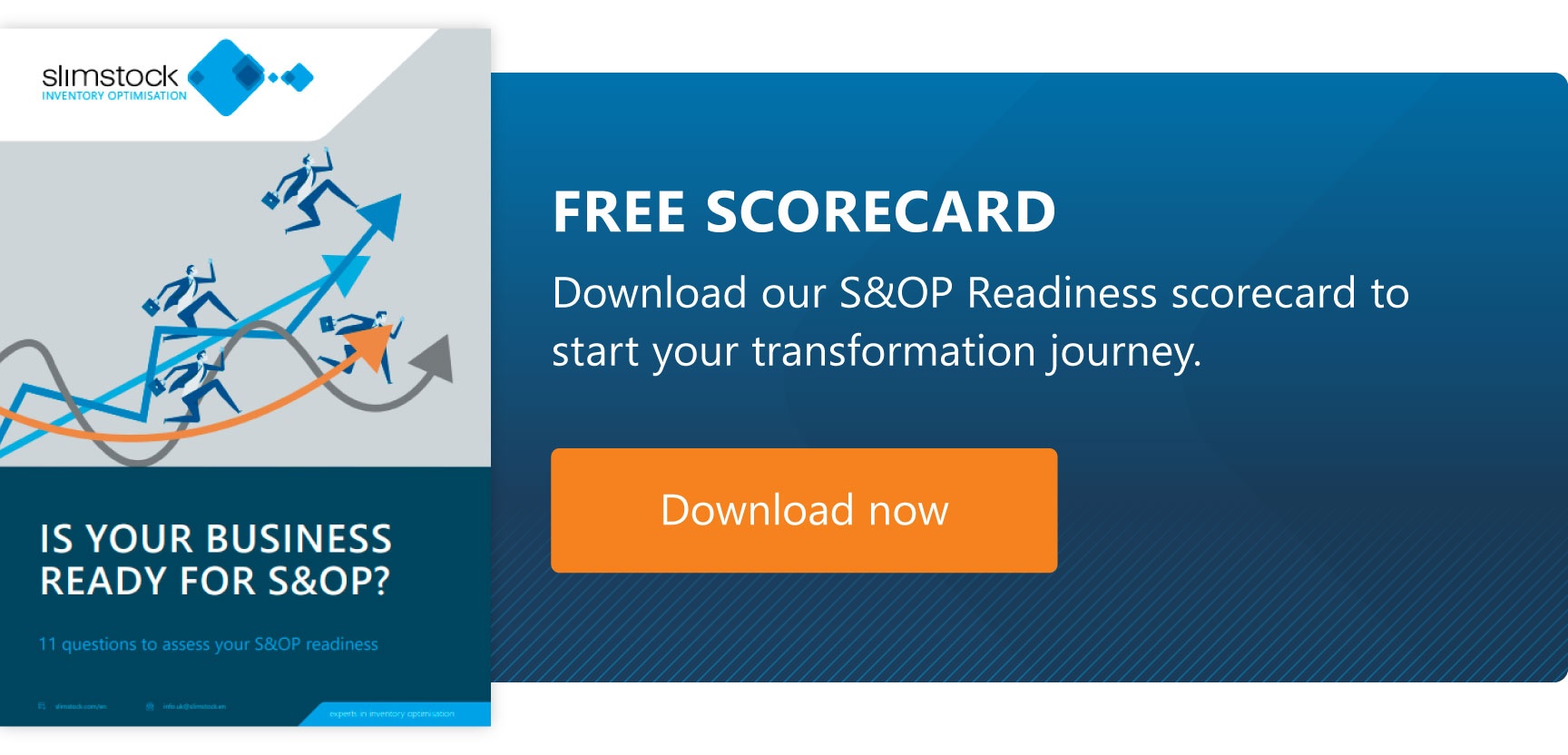Table of contents
Table of contents- The Importance of IBP and Why You Need a Strategy Behind Your Strategy
- Aligning business and supply chain strategy
- Paths to avoid on your journey
- The key to changing your IBP success
- But here is the problem..
- Beyond a failed IBP process
- The Transformation of IBP
- Phase A
- Phase B
- The perfect picture of IBP
- Integrated business planning FAQs
Imagine you wake up at 4am.
It’s the second time this has happened recently. The first time, you were worried about losing your job. Sales were low; there was a disconnect across the business. And you were supposed to have the answer at your fingertips.
But somehow you delivered the solution: Integrated Business Planning (IBP).
Now, you’re awake again at 4am, but the feeling’s different. You’re full of excited anticipation. You have a board meeting at 9am, and it’s taking place to herald you as the saviour of the company.
So how did you do it? And what part has IBP had in making you the hero of the hour?
Aligning business and supply chain strategy
You might wonder how Integrated Business Planning and Business Strategy are linked.
Most businesses are constantly trying to strike a balance between service, working capital and cost. And supply chain is at the heart of this. This is the reason why Chief Supply Chain Officers now exist and are such a crucial voice in the boardroom. It’s not by accident. It’s down to the importance of their role in your business.
Every decision you make, from the boardroom to the warehouse floor, holds the power to directly or indirectly impact your EBIT and return on capital employed.
It’s the complex dance between these elements that defines the right strategy. A strategy that not only drives your supply chain but also contributes significantly to the overall success of your business.
It can define it or undermine it. But for the former to be a possibility, your strategy should be dynamic.
After all, disruption is very much the new normal. It’s both omnipresent and unpredictable, be it from energy crises, war, rising inflation, climate crises or the rise of AI.
There’s turmoil wherever you look. And so having a plan which is adaptable is the only way to succeed.
Paths to avoid on your journey
Some businesses start their IBP journey and focus on getting the shiniest, newest and fanciest technology to solve their problems.
They look at new technology as a silver bullet to solve all the problems of the business in one fell swoop.
It will be powered by artificial intelligence or machine learning, promise the world and deliver very little.
And that’s because there is no silver bullet. It’s highly likely there never will be. Whether we’re talking about IBP or anything else.
The key to changing your IBP success
Don’t ignore your people, processes and governance.
Strong and effective Integrated Business Planning begins with having a clear vision. Everyone in your company must understand their roles in achieving your overarching objectives.
If your processes aren’t designed to run efficiently and effectively, with the correct inputs and outputs, they’re not designed well enough.
There must be alignment between your different business functions, and the right technology to underpin the strategy. On top of this, there should be clear governance, clear RACI (responsible, accountable, consulted and informed) and RAPID (Recommend, Agree, Perform, Input and Decide) and a plan for L&D and change management.
For some, just creating those elements in their business will take months or even longer. For others, the necessity of their existence will be a barrier to implementing IBP in the first place.
But that shouldn’t be the case. Because the path to IBP and supply chain excellence is an ongoing one.
The leaders in your business must treat IBP as more than a planning process upgrade.
It must be a company-wide business initiative, where the process is designed for the P&L owner, and not just individual functions within your company.
This will help your business make effective decisions.
But here is the problem..
According to McKinsey, only 29% of businesses see IBP as a long-term strategy, with business leaders chairing board meetings.
Beyond that, just 20% of businesses have data, insights and potential decision scenarios that are shared within board meetings.
And a staggeringly low 9% of companies have shared metrics and accountability to help promote cross-functional responsibility.
And that’s a problem.
Statistically, 91% aren’t going far enough in their approach to IBP to make a fundamental difference in the strategy of their supply chain success.
Beyond a failed IBP process
There are three principles which can spare your blushes because of a failed IBP implementation process.
Firstly, it must be sponsored by top management. It must be championed and supported and not seen as a tick-box exercise or disruption.
Effective IBP requires the hands-on participation of management, up to and including the leader of the business, President, CEO, COO, General Manager and Managing Director.
Secondly, there must be cross-functional collaboration and responsibility. This is absolutely crucial.
It involves, as a minimum, Sales, Marketing, Operations, Supply Chain, Product Development, Finance and Management.
And thirdly, it must be managed at the right level of granularity. Every single employee who’s involved in the process must be the right person for the job and know their role inside out in relation to making it a success.
As you can see in the graphic below, as we move from overall strategic plans towards the operational final point of supply and purchase plans, the level of detail increases.
1) 3Y Strategic Plans
Understanding of sales projections, footprint expansion, new brand activations, closures, investments.
This first level is where the strategy is defined. What new product line is coming? Which new market might be worth exploring? What happens if we open a new store?
These questions are strategic and can be addressed at this stage.
2) AOP
Annual Operating Plan with monthly sales targets per BU and category.
This is where the strategy is driven.
3) Sales & Demand Plan
Alignment between published sales plan and projected demand. Align on accepted variation and validate with top management.
4) Supply/Purchase Plan
Expected POs generated as per validated demand and agreed OSA/Inventory/Cashflow Targets. Alignment with OTB and revisions if PO>OTB for a given period.
This gives us a defined understanding of the whole alignment of IBP.
The Transformation of IBP
Integrated Business Planning is a transformation journey.
It’s highly likely you won’t get it right in the beginning. But as you improve and move through the various steps, you will get there.
Phase A
Many companies start at the low maturity stage. There’s a disconnection between processes. There’s fire fighting between teams and a focus on the past.
As IBP becomes more of a priority, so the transformation continues.
Foundations are put in place and the organisation, tools and processes evolve. But there’s a tendency here for the business to still work in silos. There may be shared KPIs and accountability, but teams are still in it for themselves.
A capable IBP is the stage that follows this.
There’s an integration with the annual plan and scenarios, and simulations are run to implement a more formal and formulated process.
Top management become part of the plan and hold detailed planning sessions with consistent reviews.
Phase B
This is the goal for most companies in maturing their IBP.
They should look to focus on the customer experience. There’s value chain focus and it’s strategically driven with a delegation and empowerment of the team.
Only from here are you able to move to a low touch IBP.
What’s a low touch IBP?
It means many of the decisions you make as a business are ‘low touch’. They don’t require huge input or strategic thinking sessions from multiple stakeholders.
In fact, they’re almost automated.
To the point where you can comfortably move to the final stage of the transformation.
Cognitive IBP.
This involves machine learning and AI to predict risks, opportunities and future problems, to drive the business in a more automated manner.
The perfect picture of IBP
The vast majority of businesses today look at IBP and focus on the technology to create success. But they forget the processes and the people: 2 absolutely crucial pieces of the IBP puzzle.
- It’s not about doing things right, it’s about doing the right things.
- IBP should not be owned by the Supply Chain.
It should be a business-wide transformation. It should be across every single business function and team. It should involve a high level of granularity in the decision-making process.
Without these elements, you’re unlikely to succeed in transforming your business.
The imaginary scenario at the beginning of this article, of waking up at 4am, is in fact a real story. And it happened to a customer of Slimstock. We took her from sleepless nights about losing her job, to sleepless nights through excitement because of her success in implementing IBP.
Now, in an ideal world, you wouldn’t lose sleep at all.
But we don’t live in an ideal world.
And because of that, you’re better off being as prepared as you can be in the turmoil of constant disruption. You’re better off implementing IBP in your business and taking on the transformation project head-on with the best tools at your disposal.
But only part of that is software.
Now, it might be unusual for a software business to say only part of the puzzle in your success is technology. But it’s very much the case.
Of course, it does help to have the best at your fingertips. But only if it helps your best people implement great processes for high level governance and ultimate success in your IBP transformation.
Integrated business planning FAQs
Why is IBP important, and why do you need a strategy behind your strategy?
IBP is crucial for business success as it integrates planning processes across various functions, ensuring alignment between business and supply chain strategy. Having a strategy behind your strategy involves understanding the dynamic nature of disruptions and adapting your approach to stay ahead.
How are Business Strategy and Integrated Business Planning (IBP) linked?
Business Strategy and IBP are linked through the delicate balance between service, working capital, and cost, with the supply chain playing a central role. Effective decision-making, driven by a dynamic strategy, is essential in the face of unpredictable disruptions, making IBP a key contributor to overall business success.
What mistakes should businesses avoid in their IBP journey?
Businesses should avoid the misconception that technology alone is a silver bullet. Overemphasis on shiny, new technology without addressing people, processes, and governance can lead to failed IBP implementations. The key is to strike a balance, recognizing that success depends on a holistic approach.
How can businesses ensure successful IBP implementation?
Successful IBP implementation starts with a clear vision, efficient processes, and strong governance. Alignment between different business functions, utilizing the right technology, and incorporating clear roles and responsibilities (RACI and RAPID) are critical. It’s a company-wide initiative, not just a planning process upgrade.
What are the common pitfalls in IBP transformation, and how can they be avoided?
Common pitfalls include insufficient top management involvement, lack of cross-functional collaboration, and inadequate granularity in planning. To avoid these, ensure strong leadership sponsorship, foster cross-functional collaboration, and manage IBP at the right level of detail. This approach enhances the chances of successful IBP transformation.










